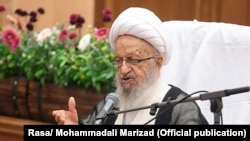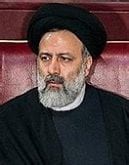Radiofarda – A Grand Ayatollah has argued that the government is indebted to Qom a city where tens of thousands of young religious students are trained to become clergymen and has demanded more money in the midst of an economic crisis.
Speaking to the Governor of Qom, 91-year-old Nasser Makarem Shirazi, officially recognized as Grand Ayatollah insisted that Qom renders invaluable service to the ruling system to the extent that the authorities will never be capable to return the favor.
Qom, where the most prominent Iranian Shi’ite clergies reside, is responsible for training Friday Prayer Leaders, judges, ideologists, prosecutors, and political theoreticians, Makarem Shirazi has boasted.
Furthermore, Makarem Shirazi has bragged about the high position of Qom, for being the center of Shi’ite seminary, mosques and other religious monuments that attracts hundreds of thousands of pilgrims to the city.
Qom doesn’t owe anything to the government, Makarem Shirazi has reiterated, adding, “the government is indebted to Qom.”
Makarem Shirazi had earlier on November 2, 2017, also called on the government to allocate an exclusive budget for Qom, “since Qom is an exceptional city, and other cities will understand the fact, without any protest.”
The elderly ayatollah’s comments were published at a time that allocating “astronomical” amounts of public money to the religious institutions triggered a barrage of criticism.
In December 2017, for the first time in almost four decades President Rouhani’s Administration dared to publish the details concerning the government’s financial assistance to the clergy-run institutions in the 2018-19 budget.
The proposed budget revealed that in total up to $500 million dollars of public money goes to the religious entities across Iran.
Radio Farda, at the time, listed the religious institutions financially assisted by the government:
$110 million for the High Council of Religious Seminaries, which oversees all religious seminaries in the country and issues permits for the establishment of new schools, among other things. Its budget shows an increase of more than 16 percent compared to the previous year.
$105 million for “supporting religious seminaries.” From that amount, $88 million will be allocated to training male clergymen and $16 million for “cultural and promotional activities” by male students of religious seminaries.
$5 million for supporting religious “research activities” by seminary students.

Clergy Demand More Money Amid Popular Anger At Economic Hardship
$150 million for the Service Center for Religious Seminaries, a welfare institution that provides support to retired and disabled clergymen and the families of deceased clergy. The institution also pays scholarships for religious seminaries and funds cultural and sports activities for students.
$29 million for the Council for Planning and Management of Religious Seminaries in Khorasan Province.
$64 million for the Policy Making Council for Women’s Religious Seminaries.
$75 million for Al-Mustafa International University, an umbrella organization for religious seminaries providing education to foreign students within and outside of Iran. This institution is also used for expanding influence abroad. It is worth mentioning that the budget allocated to Al-Mustafa University is much higher than the fund provided to some of the major regular universities, like Amir Kabir University in Tehran with $63 million, and Tabriz University with $64 million.
$23 million for the supreme leader’s representative in the Islamic Revolutionary Guards Corps (IRGC). The fund will be spent on deploying preachers, overseeing the compatibility of IRGC rules and regulations with Islam, spiritual ceremonies, and guiding and promoting political vision.
$17 million for maintaining the mausoleum and residence of Ayatollah Ruhollah Khomeini, the founder of Iran’s Islamic Republic, and for protecting his ideological heritage by publishing books and holding commemorations and conferences.
It should also be noted that funds from the government budget are only one part of the income for influential clergymen and the religious institutions they control.
Most are exempt from taxes and own huge properties and receive various donations.
Nevertheless, Makarem Shirazi has repeatedly insisted that Qom deserves more public money.
Speaking to the Governor of Qom, Makarem Shirazi, who has allegedly monopolized Iran’s sugar market, noted on Tuesday, January 15, also cautioned about an “infiltrating” group that aims to change Qom’s features, without offering any details.
The huge outlays for religious institutions last year was partly what triggered the December 2017 widespread unrest in more than 100 cities, including Qom, during which demonstrators loudly chanted slogans against the Islamic Republic’s system and the Supreme Leader.
 Shabtabnews In this dark night, I have lost my way – Arise from a corner, oh you the star of guidance.
Shabtabnews In this dark night, I have lost my way – Arise from a corner, oh you the star of guidance.



